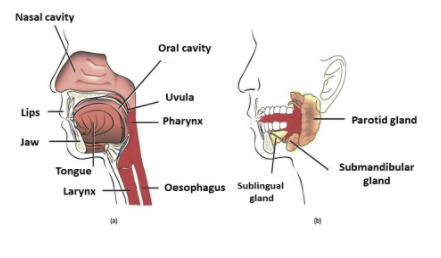
Answer
465.9k+ views
Hint: The gland is present in the side of the lower jaw bone and this gland is smaller than the other salivary glands that are found in the human oral cavity.
Complete answer:
One of the salivary excretory ducts is the submandibular duct/ Wharton duct/submaxillary duct. It drains the saliva from each of the bilateral submandibular gland and sublingual gland to the sublingual caruncle present at the base of the tongue.
Additional Information: Human beings possess 3 major pairs of salivary glands that open into the mouth via the well-developed ducts.
Parotid gland: The parotid salivary gland is the largest gland amongst the other three glands. It is situated between the ear and the lower jaw’s ascending branch. Every gland has a major duct called Stensen’s duct which opens in the back of the mouth cavity.
submandibular gland: The second pair, the submaxillary glands/submandibular glands, is situated along the side of the lower jawbone. Wharton’s duct (major duct) opens into the mouth floor at the junction where the front of the tongue meets the floor of the mouth.
Sublingual gland: The third pair is called the sublingual glands, which is located beneath the mucous membrane of the mouth’s floor. Many ducts empty near the junction of the tongue and the floor of the mouth. Various ducts combine to form Bartholin’s duct. Bartholin is the major duct of the sublingual gland. It empties the saliva into or near the submaxillary duct. These glands secrete a mixed fluid that mainly consists of mucus.

So, the correct answer is, ‘Both B and C’.
Note: The saliva produced by the salivary gland mixes the food completely. Saliva possesses immunoglobulins and lysozymes which have antimicrobial activity and inhibits the growth of certain bacteria in our mouth. It has mucous that moistens the food and also buffers the food ph. Additionally, salivary amylase is abundantly present in the saliva. The salivary amylase converts the starch present in the food to simple disaccharide maltose sugar.
Complete answer:
One of the salivary excretory ducts is the submandibular duct/ Wharton duct/submaxillary duct. It drains the saliva from each of the bilateral submandibular gland and sublingual gland to the sublingual caruncle present at the base of the tongue.
Additional Information: Human beings possess 3 major pairs of salivary glands that open into the mouth via the well-developed ducts.
Parotid gland: The parotid salivary gland is the largest gland amongst the other three glands. It is situated between the ear and the lower jaw’s ascending branch. Every gland has a major duct called Stensen’s duct which opens in the back of the mouth cavity.
submandibular gland: The second pair, the submaxillary glands/submandibular glands, is situated along the side of the lower jawbone. Wharton’s duct (major duct) opens into the mouth floor at the junction where the front of the tongue meets the floor of the mouth.
Sublingual gland: The third pair is called the sublingual glands, which is located beneath the mucous membrane of the mouth’s floor. Many ducts empty near the junction of the tongue and the floor of the mouth. Various ducts combine to form Bartholin’s duct. Bartholin is the major duct of the sublingual gland. It empties the saliva into or near the submaxillary duct. These glands secrete a mixed fluid that mainly consists of mucus.

So, the correct answer is, ‘Both B and C’.
Note: The saliva produced by the salivary gland mixes the food completely. Saliva possesses immunoglobulins and lysozymes which have antimicrobial activity and inhibits the growth of certain bacteria in our mouth. It has mucous that moistens the food and also buffers the food ph. Additionally, salivary amylase is abundantly present in the saliva. The salivary amylase converts the starch present in the food to simple disaccharide maltose sugar.
Recently Updated Pages
What is the meaning of celestial class 10 social science CBSE

What causes groundwater depletion How can it be re class 10 chemistry CBSE

Under which different types can the following changes class 10 physics CBSE

Article 46 of the Constitution of India refers to the class 10 social science CBSE

Which of the following sentences has a linking verb class 10 english CBSE

Which best describes consensus historiography A A bottomup class 10 social science CBSE

Trending doubts
Which are the Top 10 Largest Countries of the World?

How do you graph the function fx 4x class 9 maths CBSE

Fill the blanks with the suitable prepositions 1 The class 9 english CBSE

Difference between Prokaryotic cell and Eukaryotic class 11 biology CBSE

The Equation xxx + 2 is Satisfied when x is Equal to Class 10 Maths

Why is there a time difference of about 5 hours between class 10 social science CBSE

Differentiate between homogeneous and heterogeneous class 12 chemistry CBSE

What is pollution? How many types of pollution? Define it

Give 10 examples for herbs , shrubs , climbers , creepers




